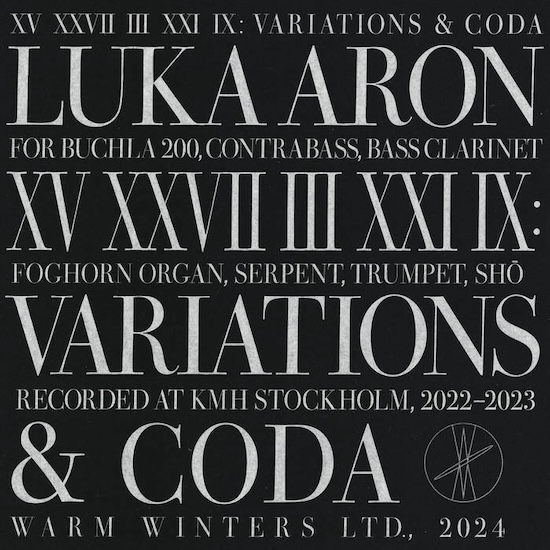If ever there was a musical moloko for the current unhappy state of the world, it is the new release by Luka Aron. Its very title, XV XXVII III XXI IX: Variations & Coda, strips us of a way to react, benumbing and becalming us before we’ve even started (unless you have a thing for maths puzzles or Latin numerals…) Nevertheless, the music sounds captivating and mysterious throughout. There is a sense of both existential remove and a contrary, niggling, remorselessness in application: a bit like Faust and Tony Conrad’s Outside the Dream Syndicate. There is also a spectral quality here, reminiscent of the “through the mirror” vignettes Jozef van Wissem conjures up. It’s great music.
To go back to that title for a second. A record’s title is traditionally there for the listener to get an inkling of the artist’s state of mind, and maybe to form an opinion on the work. But words, it seems, are secondary in Luka Aron’s austere world: the only variation on the title ‘Variation’ (I, II, III) is the name of the last track, ‘Coda’. There’s nothing to cling on to, just a sheer rock face of inscrutability. The feast after famine is served with the “selected acoustic ensemble” Aron has put together. A combination of bass clarinet, contrabass, euphonium, foghorn organ, harpsichord, serpent(!), shō, and trumpet as well as analogue and digital “synthesis”. This listing makes the record sound like a bacchanal.
And yet all these instruments are forced through a filter that brooks no deviation, akin to the colour wheel that turns to white when it hits the right speed. Opposites affect, that’s the game Aron’s playing. Things cancel each other out and movement is found in sustained tones, an ever-developing idea of flux and mutation.
‘Variation 1’ starts as the record means to go on: a seven-minute sustained mid-tone with minute tonal wobbles along the way. It makes you feel like you are looking at a piece of metal slowly being formed on a lathe. The last chemical trails of sound drift through our frontal lobes like woodsmoke as ‘Variation II’ picks up the baton and slowly grinds out a pleasing, progressive mulch of ambient noise. A brilliant, ever-so-slightly enervating example of modern chamber music using arcane instruments. I think this track is where the serpent gets a run out. I am probably wrong. The only time I have ever seen a serpent, let alone heard one used in anger, is behind a glass case in the Guards Brigade museum on Birdcage Walk.
Forgive one more metaphor around the record’s core duality: the way the music sounds could be a take on inverse kinematics. The traditional instruments act as the high energy protons, creating “incidents” whilst the analogue and digital synthesis plays the “target and binding” role of the thermal neutrons. The first role is taken by the players, here Mattias Hållsten on the shō (a Japanese mouth organ), Susana Santos Silva on trumpet, contrabassist Vilhelm Bromander, and Amina Hocine, who plays her self-built foghorn organ. Members of Aron’s electroacoustic group Minua – Fabian Willmann (bass clarinet) and Raphaël Rossé (serpent and euphonium) – complete the scene. The second role is courtesy of Aron, who, like a psychicke Prospero, sets the controls on both the Buchla 200 and EMS VCS3 and the SuperCollider and Pure Data coding environment. Thanks to all we hear the sounds of barely heard collisions.
‘Variation III’ is possibly the most adventurous of the three, a slow progression of notes that initially invoke a piece of baroque or early music (hence my thoughts wandering to Van Wissem, earlier). The illusion is shattered by a set of crashing notes that invoke a response from unknown sources and create a sort of fried afterburn of sound. But nothing ever gets out of hand or loose. Whatever chaos there is, it is always an elegant chaos.
Last up, ‘Coda’ is mildly symphonic and acts as a kind of release. There is an amount of space in the piece that is probably due to the warmer tones of what I guess to be the foghorn organ, akin to the rich shades and soft, furrowed markings of a 4B pencil instead of the austere cross hatchings of the 2H we have previously been investigating. The swells in tone grow louder and more satisfying and draw matters to a close.
This is a record that, if you let it, will really invade your living space.



